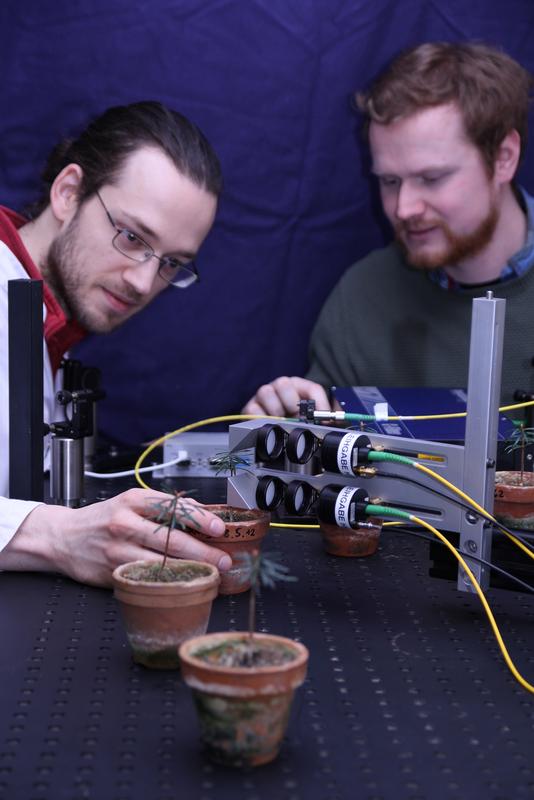Stress test for fir trees

Caption: David Behringer (left) and Norman Born adjust the measuring system. (Photo: Philipps-Universität/Ralf Gente)
This is being demonstrated in a recent publication by biologists and physicists from Marburg that appears in a special issue of the journal “Plant Physiology”. Reduced water content leads to increased permeability of the leaves for terahertz waves, the authors say. Thanks to the new method, researchers can measure stress responses in many individual plants over long periods of time.
Global climate change is expected to cause extreme weather conditions – like distinct periods of drought – in the Mediterranean and Central Europe in the future. “Most tree species are very sensitive to drought stress which is caused by lack of water”, David Behringer explains; the biologist from Marburg is co-author of the current publication.
To estimate the survival chances of plants under different environmental conditions one has to know the genetic and physiological background of drought stress tolerance in different plants as precisely as possible.
“So far, no methods for the specific investigation of stress responses of plants have been available”, adds Professor Dr. Birgit Ziegenhagen, head of conservation biology at the university of Marburg and co-author of the study. “Common measurement methods assess the drought stress either through indirect processes or the measurement leads to the destruction of the plant material.”
Therefore, the scientists used terahertz rays – electromagnetic waves in the spectrum between microwaves and infrared light. The biologists in Ziegenhagen’s group used the expertise of their colleagues from the Department of Experimental Semiconductor Physics. “It has been shown that terahertz waves are absorbed almost completely by water while they pass through many solids freely”, Professor Dr. Martin Koch explains. The physicist is also involved in the current publication.
Researchers took advantage from another characteristic of terahertz waves, as co-author Norman Born from Koch's working group says: “Since terahertz waves have a much shorter wavelength than microwave radiation, it is possible to measure the thin needles of fir trees.”
The authors tested their method on a species of fir trees because conifers with their little leaf surfaces are particularly difficult to study by conventional methods.
For the first time, the researchers from Marburg monitored a great number of plant seedlings over a period of several weeks with the new technique; by doing so, the group has been able to observe, compare and evaluate stress reactions directly. The researchers irradiated a number of plantlets repeatedly by terahertz waves, so that they were able to record the change of water content in the needles accurately and in real time. This was only possible by using the special design of the terahertz spectrometer which was developed in Marburg.
The non-destructive long-term measurements allow accurate prediction of how long a plant can tolerate drought under certain conditions. “Thanks to the new technology, it is possible to expose plants of different genotypes to the same stress to characterize deviant reaction”, says conservation biologist and co-author Dr. Sascha Liepelt. Martin Koch as Head of Experimental Semiconductor Physics is looking forward to the continuation of the research work: The “Johannes Hübner Foundation” will support the ongoing work by a scholarship; it will be used to adapt the system to other plant species and conduct in-depth studies.
Original publication: Norman Born, David Behringer & al.: Monitoring plants drought stress response using terahertz time-domain spectroscopy , Plant Physiology 2014 , pp. 113.233601v1 – 113.233601, DOI : 10.1104/pp.113.233601
For more information:
Contact:
Norman Born,
Subject Experimental Semiconductor Physics
Tel : 06421 28-24156
E -mail : norman.born@physik.uni-marburg.de
Homepage: http://www.uni-marburg.de/fb13/forschung/experimentelle-halbleiterphysik/agkoch
David Behringer,
Department of Nature Conservation Biology
Tel : 06421 28-23489
E -mail : david.behringer@biologie.uni-marburg.de
Homepage: http://www.uni-marburg.de/fb17/fachgebiete/naturschutz/naturschutzbiologie/
Press release on Forest Ecology Research (in german): http://www.uni-marburg.de/aktuelles/news/2013d/1213b
Media Contact
All latest news from the category: Life Sciences and Chemistry
Articles and reports from the Life Sciences and chemistry area deal with applied and basic research into modern biology, chemistry and human medicine.
Valuable information can be found on a range of life sciences fields including bacteriology, biochemistry, bionics, bioinformatics, biophysics, biotechnology, genetics, geobotany, human biology, marine biology, microbiology, molecular biology, cellular biology, zoology, bioinorganic chemistry, microchemistry and environmental chemistry.
Newest articles

Silicon Carbide Innovation Alliance to drive industrial-scale semiconductor work
Known for its ability to withstand extreme environments and high voltages, silicon carbide (SiC) is a semiconducting material made up of silicon and carbon atoms arranged into crystals that is…

New SPECT/CT technique shows impressive biomarker identification
…offers increased access for prostate cancer patients. A novel SPECT/CT acquisition method can accurately detect radiopharmaceutical biodistribution in a convenient manner for prostate cancer patients, opening the door for more…

How 3D printers can give robots a soft touch
Soft skin coverings and touch sensors have emerged as a promising feature for robots that are both safer and more intuitive for human interaction, but they are expensive and difficult…





















